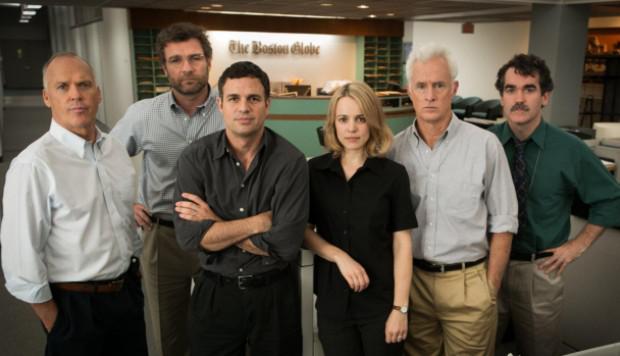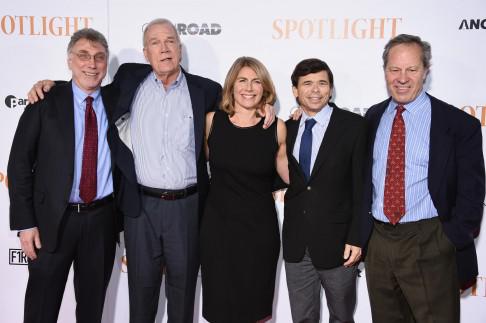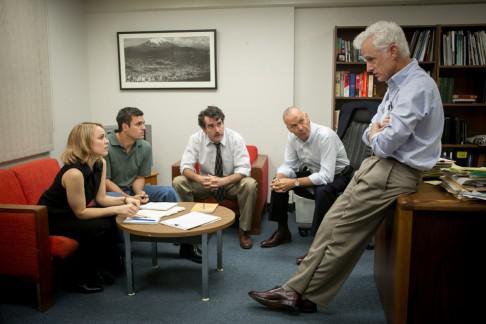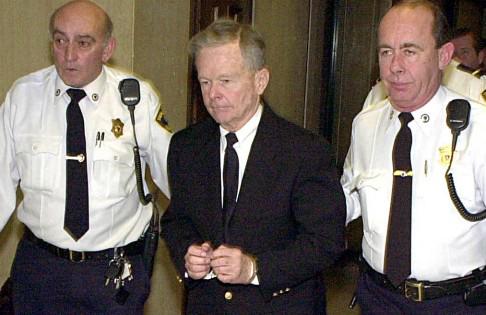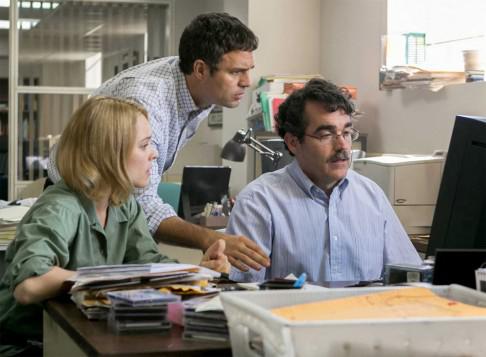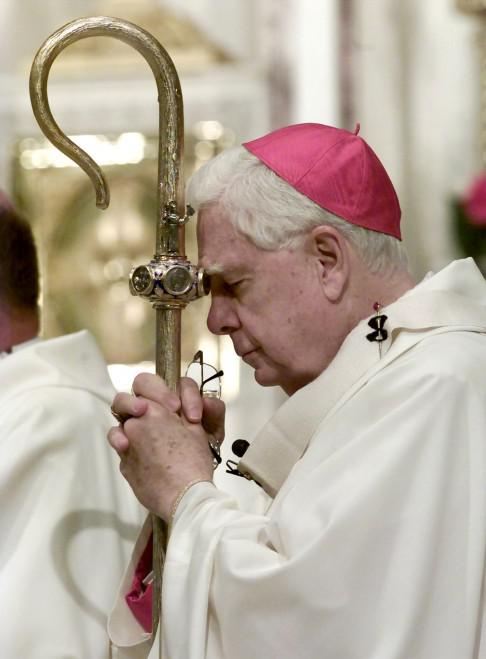|
Why investigative journalism matters and how it's best done: Spotlight film tells all
By Roy J. Harris Jnr
Story based on the Boston Globe investigation that uncovered the facilitation of child abuse by the Catholic Church dissects the news media's watchdog role, writes Roy J. Harris Jnr The best lessons about how journalists work come from seeing them in action. And no film has ever done a better job than Spotlight of showing reporters and editors in their "watchdog" role: digging out important news that others want kept secret. The film tells the story of four members of The Boston Globe's investigative unit, the Spotlight team, and follows what happens after the newspaper's editor, on his first day on the job, in 2001, tasks them with looking into the case of a defrocked Catholic priest who had been repeatedly accused of sexually abusing children in his care. This leads them to investigate whether church leaders in Boston, in the northeastern United States, knew about the abuse by that priest and by others - and protected them by quietly transferring them to new parishes, where they were free to harm other children. Because the Globe did its job so well - eventually documenting shockingly widespread abuses by priests and the cover-up by the Boston Archdiocese of a pervasive problem - Spotlight offers many lessons about the way news organisations can have a positive impact in their communities and beyond. (The Globe won the Pulitzer Prize for Public Service in 2003 for this work.) It is also rich in news literacy teachable moments. The film's biggest lesson is that bringing about truly significant societal change requires courage, risk-taking and a willingness to upset powerful people and institutions. This process begins on July 30, 2001, when Martin Baron, only recently arrived in Boston, leads his first news meeting as editor of the Globe. In a way, that meeting feels a bit like the first day of school. Lower-ranking editors nervously listen as an unfamiliar leader at the front of the room introduces himself and asks them to describe what their reporters are working on. Then Baron mentions a column, published the day before, about a lawsuit against a defrocked priest in which the documents had been "sealed" (made private by a court order). When he issues a challenge - urging the group to fight that confidentiality order and pursue a story likely to anger the powerful leadership of the Catholic Church - there's both excitement and uneasiness. Soon, members of the Spotlight team begin to collaborate in ways that exemplify the standards of quality journalism: verifying and documenting information, providing context for their readers and assuring that what they write is comprehensive, accurate and fair. These fundamental guidelines for sound reporting are on display throughout the film. Not long after that news meeting, Spotlight team leader Walter "Robby" Robinson (portrayed in the film by Michael Keaton) begins what he calls "prospecting" the story. Running the team as "player-coach", he makes assignments and edits the work of the other three members while reporting on his own. The reporters first review what the Globe has published over the years about allegations that priests had sexually molested young people, and how the archdiocese dealt with those cases. They don't find much: when accusations were made against priests, church leaders settled most cases out of court, quietly and privately. In the few instances where lawsuits had been filed, the archdiocese used legal means to get the details sealed, so that the public couldn't gain access to the documents and learn what happened. Meanwhile, Baron (Liev Schreiber) obtains approval from the paper's publisher, who represents the Globe's owners, to file an appeal in the state's Superior Court, asking that the documents be unsealed. Spotlight reporter Mike Rezendes (Mark Ruffalo) begins to talk to lawyers who have represented alleged victims of priests to get a sense of the legitimacy of their claims, and then asks to interview the clients themselves. Teammate Sacha Pfeiffer (Rachel McAdams) starts interviewing the few whose names are public. The fourth member, Matt Carroll (Brian d'Arcy James), a computer data specialist, fills a spreadsheet with information about the priests who had been accused of molestation. Robinson and Carroll devise a plan to search through years of printed church directories to see what had happened to priests accused of abuse. That information also goes into the spreadsheet, helping the reporters trace the priests' career paths. The data suggests a pattern: that church leaders are shuttling the clergymen from parish to parish rather than addressing the child molestation charges. This leads the team to widen the scope of its investigation. However, it quickly becomes clear that the team members need access to the actual documents sealed by the court if they want to say with certainty that church leaders knew of the abuse - and describe how those leaders dealt with the abusers. Bob Woodward - one of the Washington Post reporters who broke the Watergate scandal that brought down President Richard Nixon - has described the creation of a newsroom team as "assembling the perfect journalistic brain, something no one person has that I know of". Spotlight clearly shows the value of drawing on different points of view, reporting experience and skills, and temperament in such a team. We often imagine investigative journalism as the work of a single "lone wolf" reporter. Or if two or more names appear above the article, we figure they did the story on their own. But covering major news stories invariably involves teamwork that goes beyond the bylines - a reality artfully captured by Spotlight. (Note that the Spotlight team has its own office, allowing its members to work collaboratively and privately without being distracted by the daily bustle and intrusion of the main newsroom. The film also captures the undercurrent of resentment of the Spotlight team's special standing at the paper, a common sentiment wherever separate investigative teams operate.) Robinson displays a talent for recognising team members' different experience levels, interests and temperaments, and manages the team so that those qualities complement one another. Rezendes reacts to the plight of the victims with passion, while Pfeiffer and Carroll are calmer in a team setting. Pfeiffer's special skill is as a compassionate, caring interviewer who persuades reluctant victims to tell their stories in detail so that the hidden horror of the abuse can be brought to light. Without specifics, she tells them, their claims may not be believed - and that would impede any investigation that, if successful, could stop future abuses. In one memorable scene, at a team meeting, Rezendes explodes over the length of time it is taking to publish the first report. Robinson puts his foot down and declines to take Rezendes' concerns to a higher-ranking editor. In an article about the film in Variety magazine, Keaton characterised Robinson like this: "He's the guy who is easygoing, and gives everybody in the room a lot of space to do what they need to do. But when he needs to drop the hammer, he doesn't hesitate to say: 'I am not asking you. I am telling you.'" Asked about his emotional display as depicted in the film, Rezendes tells me in an email that "passion for a story can help motivate reporters and editors". After meeting with victims of priests, he adds, "I think we were all filled with a new determination to get to the bottom of the story and find the whole truth. But it's always wise - essential, in fact - to keep one's emotions in check when reviewing the facts and writing a story." A critical moment in Spotlight comes when Baron describes the various ways the Globe could frame the story. It could focus on the one priest who has been in the news - and about whom the team has learned additional information through interviews and document searches. Or it could tell the story of the larger number of priests that their reporting has identified as abusers (though with less detail). But Baron wants the Globe to instead focus on the Catholic Church, and its Boston leadership, as an "institution". The only way to stop the abuse, he explains, is to show that the church has known about the priests' grievous misconduct and has hidden it using a system to protect, rather than remove, the abusers. News organisations routinely make such decisions about how to frame the information their investigations produce - although few projects have such wide impact. As Spotlight shows, such framing dramatically shapes both the story that is produced and the kind of impact it has. The Globe's decision to focus on institutional failure means that more reporting is needed before the first articles are published (the delay that so infuriates Rezendes). It also makes the newspaper more vulnerable to the possibility that a competitor will break the news first. And, of course, there is the gnawing likelihood that the longer that publication is delayed, the more children will be abused. In this case, in fact, the choice to wait actually leads to a far greater delay than anyone could imagine - one forced on the team by the September 11 terrorist attacks. Two of the hijacked planes had departed from Boston, and the Globe reassigns all four Spotlight reporters to projects related to the attacks. The team doesn't return to the church story until mid-October. (This illustrates another basic lesson of daily news reporting: there is no story so big that it can't be put on hold by a story that's even bigger, at least at that moment.) Also, the decision to concentrate on the institution means that the reporters have to meet a higher threshold of verification - requiring extensive investigation into how the church treated abusive priests - before the first reports can be published. Those finally appear on January 6 and 7, 2002, five months after Baron's first news meeting at the Globe. The idea of fairness in journalism often involves making sure the positions of all sides involved in a story are accurately and dispassionately represented. The Spotlight team certainly did that, reaching out to priests and church officials for interviews, as well as to victims, attorneys and experts on sexual abuse. And just before the Globe published its first report, archdiocesan leaders were given a chance to respond to the allegations, point by point. But they responded to this offer with a statement saying they didn't even want to see the Globe's questions. Running throughout the film is the sense of urgency felt by the reporters - that they needed to make an extra effort to present the plight of those who were abused, in part because the news media, including the Globe, devoted little time and resources to disclosing the sexual abuse in the Catholic Church in previous years. "This was going on in every archdiocese in the country," Robinson told Variety. "And in every archdiocese, there was a major newspaper. And everybody missed it, partly because the church is the most iconic institution in any city." Far looser standards govern the making of movies like Spotlight than apply to publishing the investigative reports produced by the Spotlight team. For one thing, filmmakers don't need to give people or institutions they criticise the opportunity to respond, the way the Globe did. And movies - unless they are documentaries - invariably create dialogue, change facts or alter the sequence of events to help the dramatic flow of the story. For example, even though Spotlight aims for and achieves an unusually high level of authenticity, Eileen McNamara, the Globe columnist whose reporting drew Baron's attention to the priest story prior to his arrival in Boston, is shown attending his first morning news meeting - even though Baron says she was not there. He says of this decision by the filmmakers: "I'm sure that they needed a way to present her as a real human being." Further, by ending the movie's action with the publication of the paper's initial report, Spotlight makes only a passing mention of the more than 600 articles that followed. Within weeks, in fact, the size of the Spotlight team was doubled, adding reporters who contributed many of the subsequent reports that resulted in the paper's Pulitzer-winning work. Also played down in the film is the fact that the Globe's coverage of the church scandal was among the first major news stories to go viral on the internet. Church documents obtained by the Globe were made available online - an unusual occurrence in 2002. "It made the stories bulletproof" because readers could see for themselves that the Globe wasn't exaggerating, Ben Bradlee Jnr, the Globe's assistant managing editor for projects and investigations at that time, said during a panel discussion at a preview of the film featuring the Spotlight team. Nonetheless, staffers at the Globe, past and present, praise the film - minor misrepresentations and all. "To me, the movie is remarkably faithful to what happened," Baron, now executive editor of The Washington Post, says. "Of course, it's not a documentary." What Spotlight clearly gets right is that high-stakes news stories highlight not only the watchdog role of a free press but also the practices, values and standards that distinguish journalism at its finest. News consumers will benefit if this film fosters a greater appreciation of all of that.
|
.
Any original material on these pages is copyright © BishopAccountability.org 2004. Reproduce freely with attribution.
